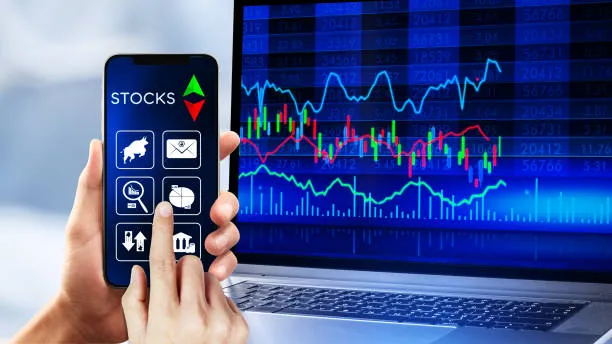This Blog, section knows what is After-market orders are one types of stock order that investors can use to buy or sell securities.
These orders are placed with a broker after the regular stock market hours have ended.
What is An After Market Order (AMO)?
An AMO is an order to buy or sell securities that are placed after the market has closed for the day.

These orders are executed in the after-hours session, which begins at 4:00 pm EST and ends at 8:00 pm EST.
⦿ There Are a Few Things To Keep in Mind When Placing An AMO.
- First, there is usually less liquidity in the after-hours session, so it may be difficult to find a buyer or seller for your order.
- Second, the bid-ask spread is usually wider in the after-hours session than during regular trading hours.
- This means that you will likely have to pay more for a stock you are buying, or receive less for a stock you are selling than you would during regular trading hours.
- Finally, not all stocks trade in the after-hours session, so you may not be able to place an AMO for your desired security.
If you’re thinking about placing an AMO, be sure to do your research and understand the risks involved before doing so.
What Are After Market Orders? (With Live Zerodha Examples)
Have you ever wondered what an after-market order is? Well, in simple terms, it is an order to buy or sell a security on a stock exchange after the market has closed for the day.
- They may have missed the opportunity to place the order during the day because they were busy at work or traveling.
- Or, the security may have gaps down/up after the market close which is an opportunity to buy/sell at a lower/higher price.
- Suppose it is 3:30 pm and you realize that you wanted to buy XYZ Ltd shares which are currently trading at Rs 100 but the market closes at 4 pm.
- In this case, you can place an after market order to buy these shares.
Zerodha is an online stock broker which allows its customers to place After Market Orders (Amo).
⦿ Here’s How you Can Do It: The Following Step
Step 1: Log in to your Zerodha account and go to the ‘Orders’ tab. Under this, you will see the ‘After Market Order’ option.
Step 2: Click on it and a new page will open where you can place your order.
Step 3: Enter the details of the trade such as the scrip name, quantity, price, etc., and click on ‘Place Order’.
Step 3: Your order will now be placed and will get executed at the opening price of the security on the next trading day.
How Does AMO’s work?
An After Market Order (AMO) is an order that is placed after the market has closed. AMO is only available during extended trading hours.

An After Market Order, or AMO, is an order that is placed after the stock market has closed for the day. This type of order is usually placed with a broker and it is not executed until the following day.
The reason why someone would place an AMO is so they can get a fill on their order at a specific price.
For example, let’s say you wanted to buy 100 shares of XYZ stock at $50 per share, but the market price was $51 per share. If you placed an AMO, you would be guaranteed to get your 100 shares at $10 each.
While an AMO does guarantee that you will get your order filled at a specific price, it is important to remember that you may not always get your order filled.
This is because there may not be enough sellers willing to sell their shares at the price you are willing to pay.
Overall, an AMO can be a helpful tool for investors who want to make sure they get a fill on their order at a specific price.
However, it’s important to remember that there are some risks involved.
- Extended trading hours are from 4:00 pm to 8:00 pm EST.
- AMO is placed through your broker and will be executed at the next available opportunity at the specified price or better.
- If you place an AMO to buy 100 shares of XYZ stock at $50 per share, your order will be filled at $50 per share or less.
- If the stock is not traded during extended trading hours, your order will be filled at the opening price on the next trading day.
- Be aware that there is often lower liquidity and higher spreads during extended trading hours, so it may be more difficult to get your order filled at your desired price.
When It Comes To Prices?
It’s important to know that after-market orders are different from regular orders in terms of prices.
With an after-market order, you’re essentially paying more for the same product.
That’s because after-market orders are placed after the market has closed for the day, so there’s no telling what the final price will be.
You might get lucky and pay less than you would have during regular hours, but it’s more likely that you’ll end up paying more.
When To Place An After Market Order?
For many investors, the end of the day is the most important time to place trades. That’s because they want to avoid any potential gaps that can occur overnight. But what if you’re looking to take advantage of post-market trading?
⦿ Here’s a quick guide on when to place an after market order.
- The first thing you need to know is that the market never really closes. There are always buyers and sellers willing to trade at the right price.
- However, the official close of the market is 4 p.m. EST. After that time, trading activity slows down significantly.
- If you’re looking to trade in the after-market, you need to be aware of the different types of orders available. The most common are limit orders and market orders.
- A limit order allows you to set a specific price at which you’re willing to buy or sell a stock. A market order simply executes a trade at the current market price.
The Different Types of After-Market Orders
An After Market Order is an order that is placed after the markets have closed. There are different types of After Market Orders, including:

Limit Orders: A limit order is an order to buy or sell a security at a specified price or better.
Stop Orders: A stop order is an order to buy or sell a security when it reaches a specified price.
Market Orders: A market order is an order to buy or sell a security at the best available price.
All or None Orders: An all or none order is an order to buy or sell a security only if the entire order can be filled.
Fill or Kill Orders: A fill or kill order is an order to buy or sell a security that must be filled immediately, or it will be canceled.
How To Place an After Market Order?
If you’re interested in purchasing security after the market close, you can place an after market order.
After market orders are placed through your broker and executed in the post-market session, which takes place from 4:00 pm to 8:00 pm EST.
⦿ Here’s How to Place An After Market Order:
1. Call your broker or log onto your brokerage account.
2. Place your order with your broker. Be sure to specify that it’s an after market order.
3. Your broker will execute the trade in the post-market session.
It’s important to note that not all securities can be traded after the market session.
Also, since there is less liquidity in the post-market session, your order may take longer to fill and you may have to pay a higher commission.
Pros and Cons of After Market Orders
After market orders can be a great tool for investors, but there are also some potential drawbacks to consider. Here are some pros and cons of after market orders:
What is An After Market Order in Share Market?
An After Market Order (AMO) is an order to buy or sell securities that are not traded on the stock exchanges during regular trading hours.

- AMO is placed with broker-dealers who execute the order in the over-the-counter (OTC) market.
- The OTC market is a decentralized market where dealers trade directly with one another, rather than through a centralized exchange.
- The OTC market is not subject to the same regulations as the exchanges, so it can be riskier.
- AMO can be placed for both buying and selling securities. When you place an AMO to buy shares, you are agreeing to pay the dealer’s asking price.
- When you place an AMO to sell shares, you are agreeing to accept the dealer’s bid price.
- AMO is often used by investors who want to buy or sell shares of a company that is not listed on a major exchange.
They can also be used to trade shares of companies that have been delisted from an exchange.
If you are thinking about placing an AMO, it is important to do your research and choose a reputable broker-dealer.
What is An After Market Order in Upstox?
An After Market Order (AMO) is an order to buy or sell securities that are not listed on the exchange during regular trading hours. The order is placed through the broker and goes to the exchange floor for execution.
- The main difference between an AMO and a regular market order is that an AMO can be placed for any security, even those that are not listed on the exchange.
- Another difference is that an AMO can be placed for any price, even if it is outside of the regular trading range.
- Lastly, AMO takes longer to execute because they are not executed during the regular trading hours.
- Overall, an AMO provides more flexibility than a regular market order, but it comes at the cost of execution time and price.
What is An After Market Order in Zerodha?
An After Market Order (AMO) is an order to buy or sell shares that get executed only after the market closes for the day. Zerodha executes AMO at 3:30 PM on all working days.
What is An After Market Order in Trading?
An after market order is an order to buy or sell a security that is placed after the regular trading hours have ended.
- These orders are usually placed with a broker and will be executed when the market opens again.
- Many investors choose to place after-market orders so that they can get into or out of a position quickly and without having to wait for the market to open.
- This can be especially helpful if you believe that the price of a security is about to move significantly in one direction or the other.
If you are new to after market orders, it is important to understand how they work and what the risks are before using them.
When After Market Order Will Be Executed?
An after market order is an order to buy or sell securities that are placed after the market has closed for the day.

After market orders are not executed until the next trading day.
Which is Better AMO or Pre-Market Order?
If you’re trying to decide whether to place an after market order (AMO) or a pre-market order, it’s important to understand the difference between the two.
After-Market Order (AMO)
AMO is only available during extended hours trading, which generally means trading after the stock market has closed for the day.
Pre-Market Order (PMO)
Pre market orders, on the other hand, can be placed during regular market hours. So, if you’re looking to trade during regular market hours, a pre-market order is your best bet.
⦿ There are some pros and cons to both types of orders.
- With an AMO, you may get a better price for your shares since there is typically less competition during extended hours of trading.
- However, there is also more risk involved because there is less liquidity and more volatility in the markets after hours.
- So, it’s important to weigh your options and make sure you’re comfortable with the risks before placing an AMO.
What Happens When We Place After Market Order?
When we place an after-market order, our order is sent to the exchange at the end of the day.
This means that our order will be executed at the next available price, which may be different from the price when we placed the order.
What Happens if Amo’s order is Not Executed?
If an After Market Order (AMO) is not executed, it is automatically canceled at the end of the day.
Alternatives to After Market Orders
If you’re looking to trade securities outside of traditional market hours, you have a few options. After market orders are one way to do this, but they’re not the only way. Here are a few alternatives to after market orders.

Extended-hours trading is trading that takes place outside of traditional market hours.
The two main types of extended-hours trading are pre-market trading and post-market trading.
- Pre-market trading occurs before the market opens, while post-market trading occurs after the market closes.
- Another option is night trading. Night trading is similar to extended-hours trading, but it takes place on a different schedule. Night trading typically takes place from 6 pm to 8 am.
Finally, you can also use limit orders. Limit orders allow you to buy or sell securities at a specified price.
So if you want to trade security after hours, you can specify the price you’re willing to pay or sell for. If there’s a match on the other side of the order, your trade will execute.
Each of these alternatives has its own set of pros and cons. Extended hours trading and night trading may be more expensive than regular trades, for example. And limit orders may not always get filled if the market is illiquid.
What’s Allowed, What’s Not allowed in Zerodha?
Zerodha Pi and Kite are web and mobile trading platforms that offer retail investors and traders a simple way to trade stocks, derivatives, commodities, and currency pairs online.
Zerodha is one of the few brokers that allow After Market Orders (AMO) on their platform.
⦿ AMO is Allowed Only on Equity Shares listed on NSE.
- There are certain conditions that must be met in order to place an AMO:
- The order can only be placed between 3:20 pm and 5:00 pm
- The order must be placed as a limit order
- The order quantity must be in multiples of 100
- The order price must be within +5% or -2% of the last traded price
- You cannot place an AMO if you have an open position in the stock
- The stock should not be in the ban period
- You cannot place more than 20% of your holdings as AMO in a single stock
Importance of After Market Order
An after-market order is an order that is placed with a broker after the market has closed for the day. After market orders are not executed until the market opens again.

- Many times, investors will place after market orders when they believe that the stock they are interested in will move in a certain direction once the market reopens.
- While after market orders can be placed for stocks, they are also commonly used for other securities such as options and futures.
- When placing an after market order, it is important to remember that there is no guarantee that your order will be filled. This is because after hours trading is often more illiquid than regular trading hours.
There are a few different types of after-market orders that you can place. A limit order is an order to buy or sell a security at a specific price.
- A Stop order is an order to buy or sell a security once it reaches a certain price.
- A stop limit order is a combination of the two and becomes a limit order once the stop price is reached.
- It is important to remember that you may not always get the price you want when placing an after market order.
- This is because there may not be enough buyers or sellers willing to trade at your desired price.
However, you can use after market orders to your advantage by using them to try and get in on a stock before it makes a big move.
Overall, after market orders can be a useful tool for investors. They can help you get in on a stock before it makes a big move and they can also help you get out of a position if the stock begins to move in the wrong direction.
Benefits of After Market Order
⦿ There are many benefits of after-market orders, but the three main benefits are:
1) After-market orders can help you get a better price for your shares.
2) After-market orders can help you protect your profits.
3) After-market orders can help you limit your losses.
FAQ {Frequently Asked Question}
What is An After Market Order in Share Market?
An After Market Order (AMO) is an order to buy or sell securities that are not traded on the stock exchanges during regular trading hours.
AMO is placed with broker-dealers who execute the order in the over-the-counter (OTC) market.
• The OTC market is a decentralized market where dealers trade directly with one another, rather than through a centralized exchange.
• The OTC market is not subject to the same regulations as the exchanges, so it can be riskier.
• AMO can be placed for both buying and selling securities. When you place an AMO to buy shares, you are agreeing to pay the dealer’s asking price.
• When you place an AMO to sell shares, you are agreeing to accept the dealer’s bid price.
• AMO is often used by investors who want to buy or sell shares of a company that is not listed on a major exchange.
When To Place An After Market Order?
⦿ Here's a quick guide on when to place an after market order.
- The first thing you need to know is that the market never really closes. There are always buyers and sellers willing to trade at the right price.
- However, the official close of the market is 4 p.m. EST. After that time, trading activity slows down significantly.
- If you're looking to trade in the after-market, you need to be aware of the different types of orders available. The most common are limit orders and market orders.
- A limit order allows you to set a specific price at which you're willing to buy or sell a stock. A market order simply executes a trade at the current market price.
What is An After Market Order in Share Market?
An After Market Order (AMO) is an order to buy or sell securities that are not traded on the stock exchanges during regular trading hours.
- AMO is placed with broker-dealers who execute the order in the over-the-counter (OTC) market.
- The OTC market is a decentralized market where dealers trade directly with one another, rather than through a centralized exchange.
- The OTC market is not subject to the same regulations as the exchanges, so it can be riskier.
- AMO can be placed for both buying and selling securities. When you place an AMO to buy shares, you are agreeing to pay the dealer's asking price.
- When you place an AMO to sell shares, you are agreeing to accept the dealer's bid price.
- AMO is often used by investors who want to buy or sell shares of a company that is not listed on a major exchange.
When After Market Order Will Be Executed?
An after market order is an order to buy or sell securities that are placed after the market has closed for the day.
After market orders are not executed until the next trading day.
What Happens When We Place After Market Order?
When we place an after-market order, our order is sent to the exchange at the end of the day.
This means that our order will be executed at the next available price, which may be different from the price when we placed the order.
1 Related Term
- Enterprise System For Managing Contract Review Workflow is?
- What Are The Functions of Supply Chain Management?
- What is WDCW Ap Gov in Management information System?
- Environmental Management System At TCS – The Complete In-depth Guide
- What Are The Primary Business Benefits of An ERP System?
- What is Capital in Business?
- What is Shares in Business?
- What is Modern Marketing?
- How To Scale Up A Business: A Complete Guide?
- What is Cash Market?
- Difference Between International Business and Domestic Business
- What is a 21st Century Fastest Growing Business?
- Why The 3 Ps Of Business Are Still Progressing?
- What is The Heliocentric Approach And Why Did Ptolemy Use it?
- What Are The Main Principles of The Geocentric Model?
- What Are The Approaches of International Business?
- What is Regulated Market?
- What is LBR Marketing Limited Company?
- MBA Project in Operations Management: The Complete Guide
- Which of The Following is True For Supply Chain Management?
- Eco Resort Management Practices Reading Answers
- What is The Role of Business Analyst?
- Characteristics of Business Economics
- How To Sell Old Coins In International Market?
- What is Geocentric Approach?
- How Many Types of Approaches Are There in International Business?
- What is The Heliocentric Approach And Why Did Ptolemy Use it?
- How to Market Yourself?
- How Many Types of Approaches Are There in International Business?
- Best Tips For A Risky Business Costume Ideas
- What are Finance Charges?
- What is Nifty Bank Graph?
- Smart Waste Management
- Who Biomedical Waste Management?
- Finance Wheels And Tires
- What is commodity market?
- Is Marketing A Good Major?
2 Conclusion of What is After Market Order
An after-market order is an order to buy or sell a security that is placed after the market closes. After-market orders are usually placed with a broker and cannot be executed until the market opens again.
While you may not be able to get the exact price you want for your stock after market orders give you the chance to buy or sell a security when the market is closed.
This can be helpful if you need to quickly execute a trade or if you want to take advantage of post-market activity.
‣ I hope friends, through this article, I have given you information about what is After Market Order You must have got the information. So share your suggestions with us.
















